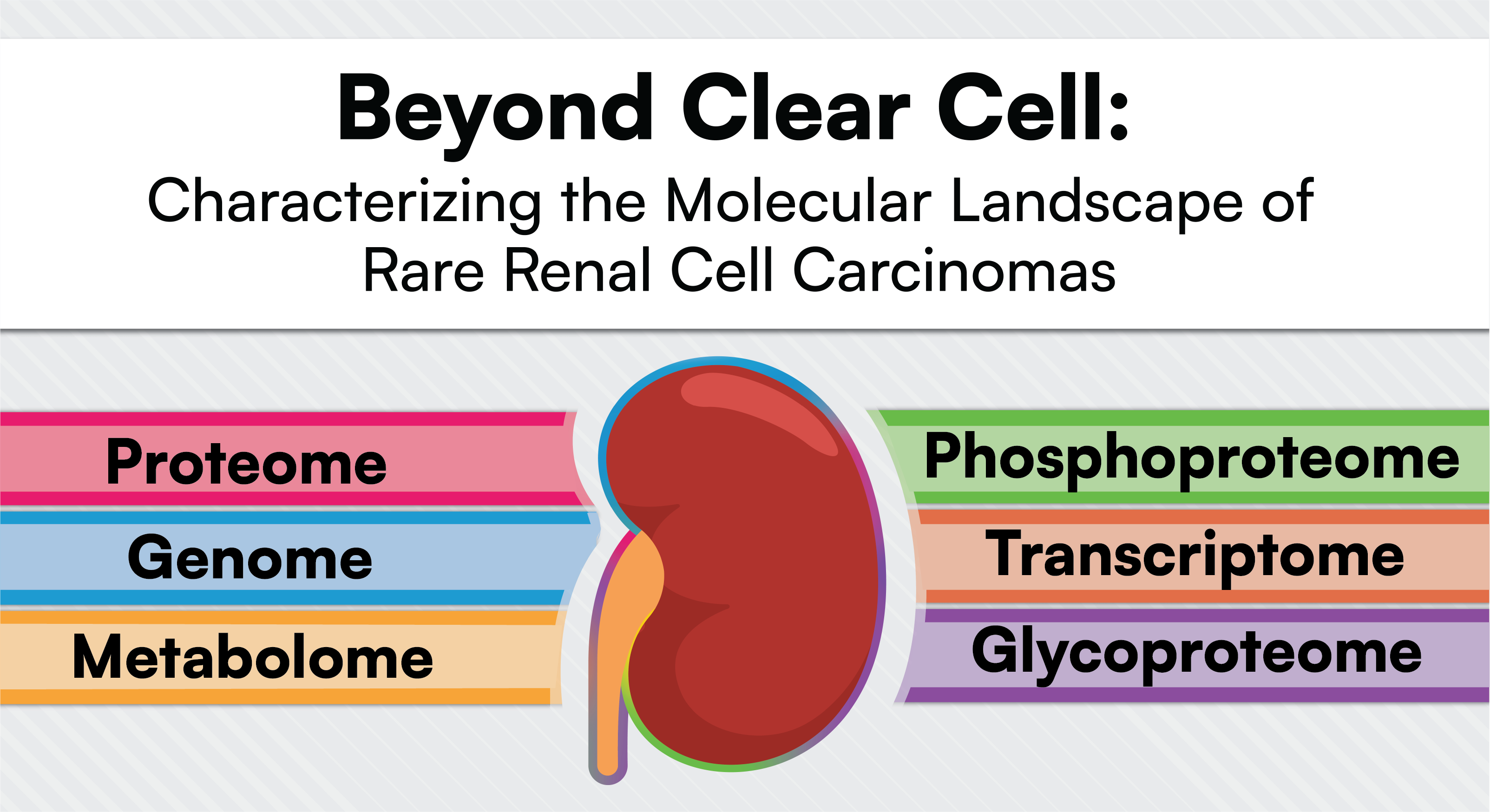In a recent study aiming to address knowledge gaps in non-clear cell renal cell carcinoma (non-ccRCC), researchers from the National Cancer Institute’s Clinical Proteomic Tumor Analysis Consortium (CPTAC) conducted an integrated multi-omic analysis of 48 non-ccRCC cases along with a previously reported clear cell RCC (ccRCC) discovery cohort. This integrative pan-renal cell carcinoma (RCC) analysis, just published in Cell Reports Medicine, sought to identify shared and subtype-specific proteogenomic, glycoproteomic, and metabolic features across RCC subtypes. Several promising biomarkers were identified and validated and, overall, the study provides a rich resource for future research with all data publicly available at the National Cancer Institute’s Proteomic Data Commons, Genomic Data Commons, and The Cancer Imaging Archive. 
“This is the first comprehensive proteogenomic characterization of rare subtypes of kidney cancer. The data sources and the novel findings from this study bring awareness of the rare types of cancer or rare subtypes of the common cancers, which often present by distinct molecular changes.”
Dr. Hui Zhang, Johns Hopkins University
Historically, single-cell studies in renal cancer have focused on immune infiltration, immunotherapy resistance, and cell-of-origin in ccRCC. Here, investigators analyzed snRNA-seq data from eight non-ccRCC samples to evaluate the transferability of ccRCC findings to non-ccRCC. Their analysis revealed wide variations in immune infiltration among different non-ccRCC subtypes. Notably, malignancies like papillary RCC (pRCC) and angiomyolipoma (AML) exhibited comparatively higher degrees of immune infiltration than chromophobe RCC (chRCC), suggesting distinct tumor microenvironments across renal tumor subtypes. Cell-of-origin analyses indicated that chRCC and renal oncocytomas (RO), likely arise from intercalated-A cells, while pRCC and several others likely arise from proximal tubule-2/B cells.
“Our study compares and contrasts rare kidney cancers to the major subtype, namely clear cell renal cell carcinoma. Biomarkers distinguishing different kidney cancer subtypes are important to make right calls, especially in challenging situations where benign counterparts show histomorphological features that overlap with malignant subtypes.”
Leo Yi Hsiao, University of Michigan
To support RCC subtyping, which often relies on histomorphological features, the group sought to identify clinically useful biomarkers by leveraging CPTAC next-generation sequencing (NGS), PTM, and global proteomics data to carry out several multi-omics analyses. The biomarkers identified in the paper hold promise for enhancing the accuracy of renal tumor diagnosis and subtype classification. For instance, the team presents SOSTDC1 as a potential marker for differentiating pRCC type-1 from other subtypes.
The investigators also coupled whole proteome profiling with phosphoproteome quantification to analyze cell signaling pathways in both non-ccRCC and ccRCC samples. Using protein abundance data from 150 RCC tumors and 101 NATs, the study provided insights into potential therapeutic targets like LATS1, CDK18, DAPK2, and more, some of which are already being evaluated in pre-clinical/clinical settings.
“We were excited to examine the associations with genome instability in the different datatypes generated in this study, from genomics, proteomics, protein glycosylation, kinase substrate and metabolome data to show the molecular differences in tumors with genome instability in both non-ccRCC and ccRCC tumors. This effort, importantly, led to the identification of biomarkers associated with genome instability that can be developed as clinical assays after independent cohort validations to improve patient care.”
Dr. Mohan Dhanasekaran, University of Michigan
Metabolic profiling revealed dysregulated metabolic pathways and metabolites in both ccRCC and non-ccRCC tumors. Findings included the identification of metabolic alterations in pentose phosphate pathway enrichment in pRCC type-1 tumors as well as glutamine catabolism enrichment in high-grade ccRCC tumors. These discoveries and others outlined in the paper provide insights into the metabolic reprogramming underlying renal tumorigenesis.
“In this study we explored/deep dived into this [metabolic] space to capture RCC subtype specific metabolite differences and identified oncometabolites for oncocytic tumors. Moreover, our kinase-substrate network analysis showed fascinating differences in the kinase activity landscape across the different kidney cancer subtypes that simultaneously captures underlying disease mechanisms while offering insights into potential therapeutic avenues.”
Ginny Xiahoe Li, University of Michigan
In an exploration of glycosylation patterns in RCC, the team analyzed both phospho-enriched data and glyco-enriched data to uncover differentially expressed glycoproteins and the roles they may play in modulating immune and endothelial cell functions within the tumor microenvironment (TME). Increased FUT8 and increased glycosylation of c-MET stood out as potentially playing a key role in renal TME dynamics.
“This work is another example of what CPTAC does better than anyone else – from generation of highest quality multi-omics data to excellent patient metadata annotation and data quality control, to most advanced proteogenomics data integration. As a results, we are able to address important biological questions and, hopefully, improve patient care in the future.”
Dr. Alexey Nesvizhskii, University of Michigan

